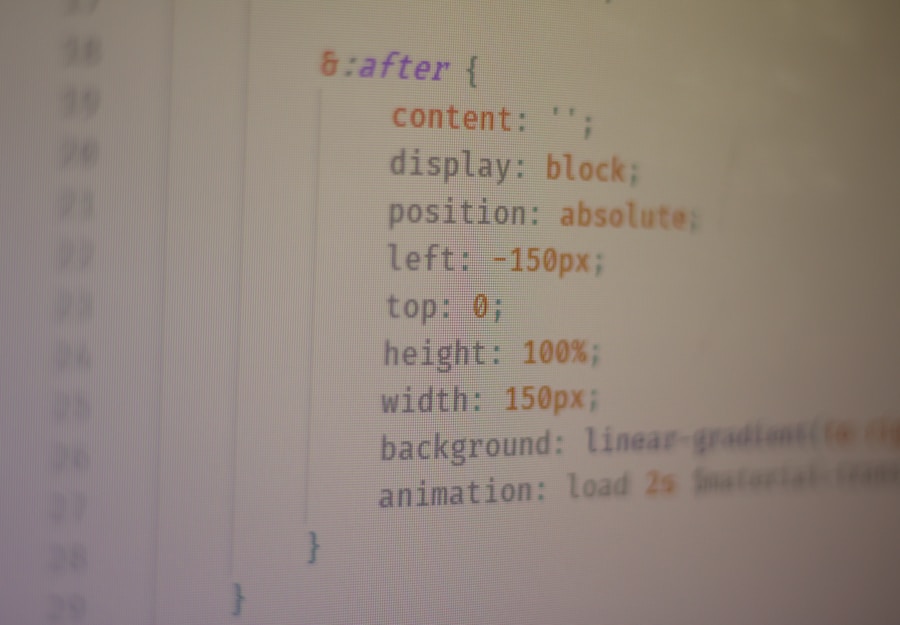When I first dipped my toes into the world of web development, I was overwhelmed by the sheer volume of information available. It felt like trying to drink from a fire hose. However, understanding the basics is crucial for anyone looking to create a website or web application.
At its core, web development is the process of building and maintaining websites. It encompasses everything from simple static pages to complex web applications that can handle thousands of users simultaneously.
Front-end development focuses on what users see and interact with on their screens, while back-end development deals with the server-side logic and database interactions that power those user experiences. As a founder, grasping these fundamentals will help you communicate effectively with your development team and make informed decisions about your project.
Key Takeaways
- Web development involves creating and maintaining websites and web applications.
- The right programming language for web development depends on the specific needs and goals of the project.
- Front-end development focuses on creating visually appealing and user-friendly interfaces for websites.
- Back-end development involves building the behind-the-scenes functionality and infrastructure of a website.
- Database management is crucial for storing and organizing data used in web development.
Choosing the Right Programming Language for Web Development
Front-end Development
If you’re looking to create a dynamic website with interactive features, JavaScript is a must-have. It’s the backbone of front-end development and is widely used for creating responsive user interfaces.
Server-side Functionality
On the other hand, if your project requires robust server-side functionality, languages like Python or Ruby might be more suitable. Python is known for its simplicity and readability, making it an excellent choice for startups looking to iterate quickly.
Making the Right Choice
Ultimately, the right programming language will depend on your project requirements, team expertise, and long-term goals.
Front-End Development: Creating User-Friendly Interfaces
Front-end development is where the magic happens—it’s all about creating user-friendly interfaces that engage visitors and keep them coming back for more. As a founder, I can’t stress enough how important it is to prioritize user experience (UX) in your design process. A well-designed interface can significantly impact user retention and conversion rates.
This means investing time in understanding your target audience and their needs. To create an effective front-end experience, you’ll want to focus on several key elements: layout, color scheme, typography, and responsiveness. A clean layout helps users navigate your site easily, while a cohesive color scheme can evoke emotions and reinforce your brand identity.
Typography plays a crucial role in readability and accessibility, so choose fonts that are easy on the eyes. Lastly, ensure that your website is responsive—meaning it looks great on all devices, from desktops to smartphones. This adaptability is essential in today’s mobile-first world.
Back-End Development: Building the Foundation of a Website
| Topic | Metrics |
|---|---|
| Server-Side Languages | PHP, Python, Ruby, Java |
| Database Management Systems | MySQL, PostgreSQL, MongoDB, Oracle |
| Server Environment | Apache, Nginx, IIS |
| API Integration | REST, SOAP, GraphQL |
| Security Measures | SSL, Encryption, Authentication |
While front-end development captures users’ attention, back-end development is where the real work happens behind the scenes. This aspect of web development involves creating the server-side logic that powers your website’s functionality. As a founder, understanding back-end development is vital because it directly impacts how your application performs and scales.
Back-end developers work with databases, server configurations, and application programming interfaces (APIs) to ensure that data flows smoothly between the front end and back end. They often use languages like PHP, Python, or Node.js to build robust server-side applications. Additionally, they must consider security measures to protect user data and ensure compliance with regulations like GDPR.
A solid back-end foundation will not only enhance user experience but also provide a scalable architecture that can grow with your business.
Database Management for Web Development
Database management is a critical component of web development that often gets overlooked by founders who are more focused on design and user experience. However, a well-structured database is essential for storing and retrieving data efficiently. As your application grows, so does the amount of data you need to manage—this is where effective database management comes into play.
For instance, if you need complex queries and transactions, a relational database might be the best fit. On the other hand, if you’re dealing with large volumes of unstructured data, a NoSQL database could offer more flexibility.
Regardless of your choice, investing time in database design will pay off in terms of performance and scalability.
Web Development Best Practices and Standards
As I navigated my way through web development, I quickly learned that adhering to best practices and standards is crucial for creating high-quality websites. These guidelines not only improve code quality but also enhance user experience and accessibility. For instance, following semantic HTML practices ensures that your website is easily understood by search engines and assistive technologies.
Another best practice is to keep your code organized and maintainable. This means using clear naming conventions for variables and functions, as well as commenting on your code where necessary. Additionally, implementing version control systems like Git can help you track changes and collaborate effectively with your team.
By following these best practices, you’ll create a solid foundation for your web project that can adapt to future changes and improvements.
Testing and Debugging in Web Development
Testing and debugging are integral parts of the web development process that can make or break your project. As a founder, I learned early on that releasing a product without thorough testing can lead to disastrous consequences—think lost users and damaged reputation. Therefore, it’s essential to implement a robust testing strategy that covers various aspects of your application.
There are several types of testing to consider: unit testing focuses on individual components; integration testing checks how different parts of your application work together; and end-to-end testing simulates real user scenarios to ensure everything functions as expected. Additionally, debugging tools can help identify issues in your code before they reach production. By prioritizing testing and debugging, you’ll not only improve the quality of your product but also instill confidence in your users.
Launching and Maintaining a Successful Website
After months of hard work, it’s finally time to launch your website! But remember, launching is just the beginning of your journey. As a founder, I’ve learned that maintaining a successful website requires ongoing effort and attention.
This includes monitoring performance metrics, gathering user feedback, and making continuous improvements based on that data. One key aspect of maintenance is ensuring that your website remains secure and up-to-date with the latest technologies. Regularly updating software dependencies and implementing security patches can help protect against vulnerabilities that could compromise user data.
Additionally, engaging with your audience through regular content updates or feature enhancements can keep them invested in your brand. In conclusion, web development is an intricate process that requires careful planning and execution. By understanding the basics of web development, choosing the right programming languages, focusing on user experience, managing databases effectively, adhering to best practices, testing thoroughly, and maintaining your site post-launch, you can set yourself up for success.
If you’re feeling overwhelmed by any part of this process or need expert guidance along the way, consider partnering with Witarist as your trusted tech partner. Our team specializes in helping startups like yours navigate the complexities of web development—from MVP creation to hiring vetted developers who understand your vision. Ready to take the next step?
Let’s turn your ideas into reality together! Reach out today to discuss how we can help you build a successful online presence that resonates with your audience.
If you are interested in learning more about web development, you may want to check out this article on what frameworks are and why we use them. Frameworks are essential tools for developers to streamline the development process and create more efficient and scalable applications. Understanding the benefits of using frameworks can help you become a more proficient web developer.
FAQs
What is web development?
Web development refers to the process of building and maintaining websites. It involves tasks such as web design, web content development, client-side/server-side scripting, and network security configuration.
What are the key skills required for web development?
Key skills required for web development include proficiency in programming languages such as HTML, CSS, and JavaScript, as well as knowledge of web development frameworks, version control systems, and web design principles.
What are the different types of web development?
There are three main types of web development: front-end development, back-end development, and full-stack development. Front-end development focuses on the visual and interactive aspects of a website, back-end development involves server-side programming and database management, and full-stack development encompasses both front-end and back-end development.
What are some popular web development frameworks and tools?
Some popular web development frameworks and tools include React, Angular, Vue.js for front-end development, Node.js, Django, Ruby on Rails for back-end development, and Git for version control.
What are the career opportunities in web development?
Career opportunities in web development include roles such as web developer, front-end developer, back-end developer, full-stack developer, web designer, and web development manager. Web developers can work in various industries such as technology, e-commerce, marketing, and finance.










